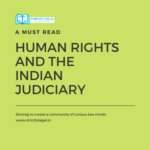I’ve read in a book that – Solitude is a luxury enjoyed by only those few animals who occupy a position on the top of the food chain.
This article was submitted by Parijat Karan currently pursuing law at Bihar Institute of Law.
Everyone needs to form alliances with other members of their species so they can live a little longer. As a concept, solitude and, consequently, privacy is utterly alien to nature, so how did human beings evolve and cleave to it so strongly that they now universally accept it as being so fundamental to the very notion of humanity as to be above the written law?
At the early stage of our existence, we were not different from other animals. As a matter of fact, we were one of them. It was necessary for some members of the tribe to guard the others when they were sleeping. Privacy or solitude was not only alien to them; they were downright dangerous. For that reason, early humans lived together in close proximity.
As the global temperatures changed and the weather grew moist and more humid, men discovered cereals and legumes. These provided new nutritional possibilities. Humans no longer needed to solely rely on other animals for their food. As a result, women began to bear more children than was possible earlier and the population started to grow. As the remaining adults had new foods to rely on, they neglected hunting to a large extent which increased the rate of survival and as a result the number of adult populations gradually increased. Humans had to settle down somewhere due to the increasing population and that led to the formation of permanent camps to better sustain their expanding number.
The social construct of our early societies was egalitarian. Everyone remained happy and no one tried to get ahead. Everyone had to work for the common good for their survival. For that kind of system, it was impossible to have any personal space. There was constant surveillance on the activities of every member to ensure that no one hinders the protection of some other. Humans at that had to live up to the expectations of the society in every aspect of their being whether very personal or something very basic. The constant performance anxiety was present in every member of the group.
When humans started developing walls, it was in almost every instance only to support the roof or to provide shelter from the rain. The constant surveillance of society was still there. Eventually, the wall was extended to the development of houses, and with that, it was for the first time that man had a space to live without the constant social surveillance. This opportunity gave rise to freedom of thought and action that had never existed hitherto. This freedom made it possible for humans to create art and science. This was, in some way, the beginning of the concept of privacy and the possibilities it created.
The advent of the concept of privacy in the legal field
With the growth of technology, the concept of privacy too saw its growth. Technology-enabled privacy, but it was also its darkest enemy. Humans found ways to breach the privacy of others by the use of developing technologies. The first major article, which is considered a masterpiece till now, was published in Harvard Law Review by Warren and Brandeis in 1890. The article itself was named “ The Right to Privacy “ and was the most influential article regarding the subject of privacy. Although James Madin tried to articulate something like a right to privacy in the American Constitution, he failed to owe to the difficulty in language at that time. It was Justice Thomas Cooley who articulated the concept in a language that is used today. It was in his “Treatise on the law of Torts”.
Meanwhile India, under British rule, never heard of privacy as a concept as it was an operation country/state. The citizens of India were never really free enough to think of something as a personal right. Even after 1947, i.e. India’s Independence, there were only a few instances where privacy was discussed in the courts of India but it never became a public furor until the Aadhar case. The first mention of the right to privacy was in a Supreme Court ruling in the case of M.P. Sharma v. Satish Chandra. The other prominent cases concerning privacy issues were the cases of Kharak Singh v. State of UP, Govind v. State of Madhya Pradesh and the Auto Shankar case.
Coming almost 6 decades after the independence of India, the UPA government came up with the Aadhar card plan under UIDAI. A lot of data had to be collected for the program. It is interesting to know that even though the Aadhar card was a program of the government, it didn’t have legal backing and there was no privacy law to check a breach in place. After consideration, the program was launched and the government, being disingenuous, assured the protection of its people.
The final nail was the well-known Puttaswamy judgment which changed our notion of the right to privacy. On 24 August 2017, a nine-judge bench delivered a decision that ran into 547 pages and is the most expansive and deeply deliberated discussion on privacy law in the Indian legal jurisprudence. The judgment stated that privacy is an integral part of the Constitution of India and was a part of the fundamental right provided by the Constitution even though it wasn’t written. The nine judges recognized the benefits provided by the modern data-driven world and how it would enable the less fortunate to improve their lives. At the same time, they were mindful of the devastating consequences of adopting modern technologies blindly.
Now, as we are surrounded by a plethora of data, we should be using it beneficially to innovate while being cautious of the privacy aspect. India will have to keep learning from other countries and organizations to unlock the full potential of data-keeping privacy in mind. The company needs to be responsible for who is working with the data as no ordinary man reads the T&C before using the product. Data is the new oil and needs to be used effectively and its breach must be dealt with maximum possible punishment.
I’ve read in an article that instead of conceptualizing privacy with the traditional method, we should instead understand privacy as a set of family resemblances. In Philosophical Investigations, Ludwig Wittgenstein argued that some concepts do not have “one thing in common” but “are related to one another in many different ways.” Instead of being related by a common denominator, some things share “a complicated network of similarities overlapping and criss-crossing: sometimes overall similarities, sometimes similarities of detail.” In other words, privacy is not reducible to a singular essence; it is a plurality of different things that do not share one element in common but that nevertheless bear a resemblance to each other.
It sounds trite but with the ever-increasing use of different technologies in the modern world, we can only hope that the people responsible for our protection would do the same and eventually develop ways to protect our right to privacy.

Users not registered with Strictlylegal can Email us their content and the same are posted through this account. In case of abuse, kindly let us know at [email protected]





